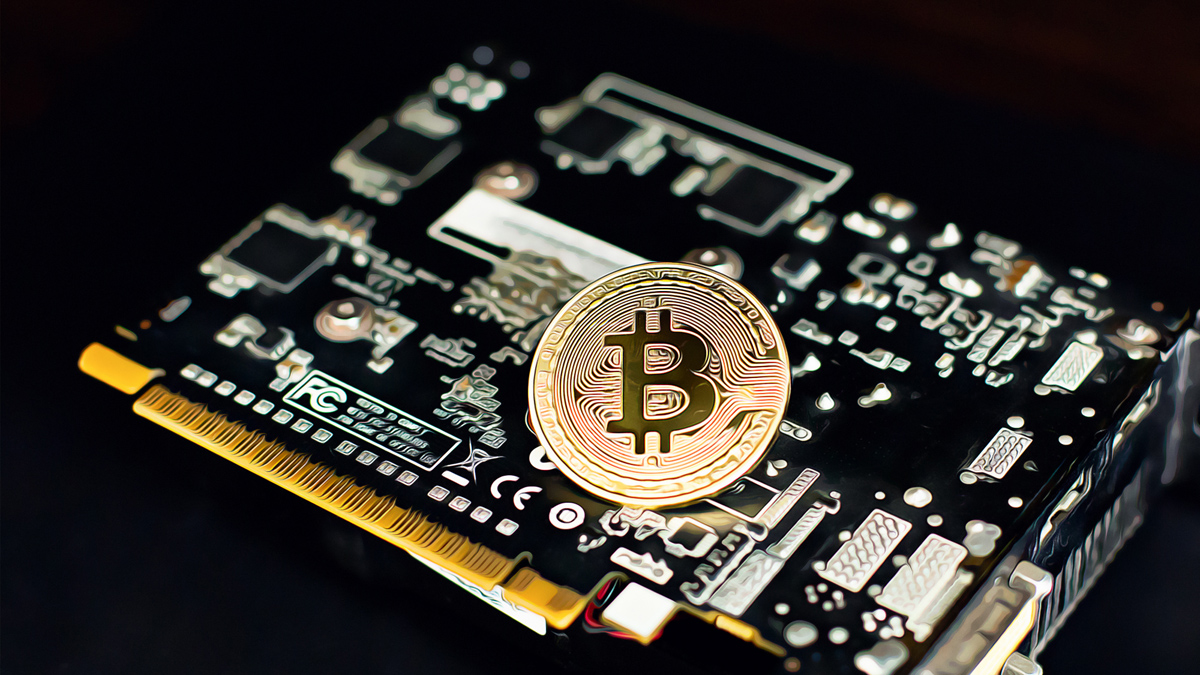
The Ethereum Foundation undergoes a significant leadership change today. Aya Miyaguchi transitions from Executive Director to President. Continue Reading: Major Leadership Shift at Ethereum Foundation Sparks Excitement The post Major Leadership Shift at Ethereum Foundation Sparks Excitement appeared first on COINTURK NEWS .
CoinTurk News
You can visit the page to read the article.
Source: CoinTurk News
Disclaimer: The opinion expressed here is not investment advice – it is provided for informational purposes only. It does not necessarily reflect the opinion of BitMaden. Every investment and all trading involves risk, so you should always perform your own research prior to making decisions. We do not recommend investing money you cannot afford to lose.
Urgent Warning: ECB Advisor Brands Bitcoin Reserves a ‘Risky Speculative Asset’

Just when Bitcoin seemed to be gaining mainstream traction, a stark reality check has emerged from the heart of European finance. Jürgen Schaaf, an influential advisor at the European Central Bank (ECB), has delivered a scathing critique of Bitcoin, dismissing the notion of Bitcoin reserves as a viable strategy for central banks. His comments, reported by Cointelegraph, paint a picture of Bitcoin as a dangerously volatile and fundamentally flawed asset, especially in the context of current market turbulence where Bitcoin has dipped below $88,000, triggering massive crypto liquidations worth $1.5 billion in just 24 hours. Is this just another dismissive voice from traditional finance, or does Schaaf’s perspective hold critical insights for anyone involved in the crypto space? Why ECB Advisor Dismisses Bitcoin Reserves as Unsuitable? Schaaf’s argument against Bitcoin reserves isn’t a casual dismissal; it’s a structured critique based on what he perceives as Bitcoin’s inherent weaknesses. He argues that unlike traditional reserve assets like oil or raw materials that underpin economic activity, Bitcoin lacks fundamental economic necessity. Let’s break down his key points: Volatility Concerns: The most prominent reason for Schaaf’s skepticism is Bitcoin’s notorious price volatility. He emphasizes that holding such a volatile asset as part of national or central bank reserves would introduce unacceptable instability. Recent market events, with Bitcoin plummeting and causing widespread crypto liquidations , only reinforce this concern. Lack of Economic Necessity: Schaaf questions Bitcoin’s fundamental utility in the real economy. He contends that Bitcoin doesn’t serve a crucial economic purpose in the same way that essential commodities do. This lack of inherent economic backing, in his view, makes it unsuitable for reserve status. Manipulation Susceptibility: The ECB advisor also points to Bitcoin’s vulnerability to market manipulation. The relatively nascent and still somewhat unregulated nature of the crypto market makes it prone to price swings influenced by large players or coordinated actions. This susceptibility further undermines its credibility as a stable reserve asset. Fuels Speculation: Schaaf believes that incorporating Bitcoin into reserves would not stabilize economies but rather exacerbate speculative activities. He fears that it would legitimize and encourage further risky investments in an asset class he considers inherently risky . In essence, Schaaf’s viewpoint is rooted in a traditional economic perspective that prioritizes stability, intrinsic value, and tangible economic utility – qualities he believes Bitcoin fundamentally lacks. The Broader Implications of Calling Bitcoin a ‘Risky Speculative Asset’ Schaaf’s description of Bitcoin as a ‘risky speculative asset’ isn’t just academic jargon; it carries significant weight, especially coming from an ECB advisor . Such pronouncements can influence regulatory discussions, institutional investment decisions, and public perception of cryptocurrencies. Here’s why this characterization matters: Regulatory Scrutiny: When influential figures like Schaaf label Bitcoin as ‘risky,’ it reinforces arguments for stricter regulation. Governments and regulatory bodies may become more inclined to impose tighter controls on the crypto market to protect consumers and financial stability. Institutional Hesitation: Large institutional investors, who are often risk-averse, might be further deterred from allocating capital to Bitcoin and other cryptocurrencies. The ‘ risky speculative asset ‘ label can solidify Bitcoin’s image as too volatile for serious institutional portfolios. Public Perception: Negative pronouncements from trusted financial authorities can sway public opinion. If the general public perceives Bitcoin primarily as a ‘ risky speculative asset ,’ adoption rates could be hindered, and skepticism towards cryptocurrencies could grow. Impact on Market Sentiment: Comments from the ECB advisor , especially during market downturns and significant crypto liquidations , can exacerbate negative market sentiment. Such statements can contribute to fear, uncertainty, and doubt (FUD), potentially leading to further sell-offs. However, it’s crucial to consider that Schaaf’s perspective represents one viewpoint within the broader financial landscape. Many proponents of Bitcoin argue that its decentralized nature, limited supply, and potential as a hedge against inflation are compelling reasons for its inclusion in reserves and portfolios. Diversified Crypto Reserves: An Even Riskier Proposition? Interestingly, Schaaf didn’t just dismiss Bitcoin; he also rejected the idea of central banks holding diversified crypto reserves. He argued that diversifying across multiple digital assets would only amplify risk and volatility rather than mitigate it. Is he right? Let’s consider this: Argument Supporting Schaaf’s View Counterarguments Increased Complexity: Managing a portfolio of various cryptocurrencies adds significant complexity in terms of security, custody, and understanding the nuances of each asset. Diversification, even within a volatile asset class, can still reduce overall portfolio risk compared to holding just one volatile asset. Correlation Risks: Many cryptocurrencies exhibit high correlation, especially during market downturns. Diversification might not provide the intended risk reduction if all assets move in the same direction. While correlations exist, they are not perfect. Different cryptocurrencies have different use cases and market dynamics, potentially offering some level of diversification benefit. Regulatory Uncertainty: The regulatory landscape for cryptocurrencies is still evolving and varies significantly across jurisdictions. Holding a diversified crypto portfolio increases exposure to regulatory risks across multiple assets and regions. Active management and careful selection of cryptocurrencies with clearer regulatory paths can mitigate some of these risks. Schaaf’s stance reflects a conservative approach, prioritizing simplicity and minimizing perceived risks. However, proponents of crypto diversification argue that strategic allocation across different types of digital assets – such as those focused on smart contracts, privacy, or decentralized finance (DeFi) – could potentially offer a more balanced risk-reward profile over the long term. Navigating the Volatile Crypto Market: Actionable Insights Whether you agree with the ECB advisor or not, the reality of Bitcoin’s volatility and the risks associated with the crypto market are undeniable. Here are some actionable insights for navigating this landscape: Educate Yourself: Thoroughly understand the assets you are investing in. Don’t rely solely on hype or headlines. Learn about the technology, use cases, and risks associated with each cryptocurrency. Manage Risk: Only invest what you can afford to lose. Given the volatility, treat crypto investments as high-risk and allocate your portfolio accordingly. Diversify (Cautiously): If you choose to invest in crypto, consider diversification, but do so strategically. Don’t just buy every coin; focus on projects with solid fundamentals and long-term potential. Stay Informed: Keep up-to-date with market news, regulatory developments, and technological advancements in the crypto space. Information is your best tool for navigating volatility. Consider Long-Term Perspective: Crypto markets are prone to short-term fluctuations. If you believe in the long-term potential of blockchain technology and cryptocurrencies, focus on long-term investment horizons rather than trying to time the market. Conclusion: A Contrarian Viewpoint or a Sobering Reality Check? Jürgen Schaaf’s critique of Bitcoin reserves serves as a powerful reminder of the skepticism that still surrounds cryptocurrencies within traditional financial institutions. His warnings about volatility, lack of economic necessity, and the risky nature of Bitcoin cannot be ignored, especially in light of recent market events and significant crypto liquidations . While proponents champion Bitcoin’s disruptive potential and long-term value proposition, voices like Schaaf’s urge caution and highlight the inherent uncertainties. Ultimately, the debate around Bitcoin’s role in the global financial system is far from settled, and understanding both sides of the argument is crucial for making informed decisions in this rapidly evolving landscape. To learn more about the latest crypto market trends, explore our article on key developments shaping Bitcoin price action. CoinTurk News

Exciting Sneak Peek: Amazon’s Alexa Event to Unleash AI Revolution
Get ready for a potential paradigm shift in how we interact with technology in our homes! Amazon is gearing up to host a highly anticipated Alexa-centric event this Wednesday in the bustling heart of New York City. For those in the crypto and tech world, this isn’t just another gadget launch; it’s a glimpse into the evolving landscape of AI and its integration into everyday life, much like the decentralized technologies we are passionate about. With the last major device showcase nearly two years behind us (September 2023), the tech giant is expected to make some significant waves. Bitcoin World will be on the ground, bringing you real-time updates as they unfold, because while the event won’t be live-streamed, the insights gained are too crucial to miss. What’s Buzzing at the Amazon Alexa Event? Under the leadership of Panos Panay, Amazon’s new devices and services chief and a former Microsoft Surface luminary, the event kicks off at 10 a.m. Eastern. The stakes are undeniably high. Amazon’s Alexa venture, despite its widespread presence in hundreds of millions of homes, has reportedly been a multi-billion dollar drain. CEO Andy Jassy has reportedly tasked the hardware division with a critical mission: to chart a course towards profitability, likely through innovative monetization strategies such as subscriptions, service fees, and value-added offerings. Wednesday could be the day we see the curtain lifted on one of these pivotal subscription models. The Dawn of Generative AI Alexa: A New Era of Smart Assistance Whispers within the industry suggest Amazon is poised to unveil a dramatically enhanced Generative AI Alexa experience, internally dubbed ‘Remarkable Alexa.’ The ambition? To make conversations with Alexa feel as fluid and intuitive as engaging with advanced AI models like ChatGPT. Imagine an Alexa that truly understands context, anticipates your needs, and responds with human-like nuance. This isn’t just about voice commands anymore; it’s about creating a genuine AI companion within your home. The rumored price point for this premium, upgraded Alexa experience is between $5 and $10 per month. But what will this subscription unlock? Multi-Command Mastery: Forget sequential requests. The new Alexa is said to handle multiple commands in a single breath, streamlining your interactions. Autonomous Actions: Imagine delegating tasks to Alexa and letting it proactively manage them, learning your preferences and routines over time. Contextual Awareness: Building on teasers from the 2023 event, this Alexa promises to leverage generative AI to grasp the context of your requests, leading to more personalized and relevant responses. Amazon hinted at these capabilities last year, promising backward compatibility with existing devices. The integration of generative AI is key to delivering this enhanced, personalized experience. Elevating the Smart Home Experience with Amazon Alexa Beyond just conversational AI, improved Smart Home capabilities are expected to be a central theme at the event. Reports indicate collaborations between Amazon and numerous companies, leveraging developer tools announced in 2023. Think deeper integrations and more intuitive control over your connected devices. Amazon’s previous announcements highlighted partnerships with brands like iRobot and Philips, focusing on features that simplify ‘scene controls’ and enable Alexa to better interpret user intent for their devices. For example, imagine saying “Alexa, goodnight,” and having it not only turn off the lights but also adjust the thermostat, lock the doors, and set your smart coffee maker for the morning – all based on learned routines and preferences. Navigating the Challenges of Generative AI in Amazon Alexa However, the integration of generative AI isn’t without its hurdles. A critical question looms: can this new, AI-infused Amazon Alexa overcome the inherent flaws of current generative AI technology? Reports from late last year painted a picture of an early iteration of the upgraded Alexa struggling with even basic commands, like toggling smart lights. Generative AI’s tendency to occasionally ‘hallucinate’ or provide inaccurate information raises concerns about reliability, especially when compared to the more predictable, rule-based systems that underpin today’s Alexa. The silver lining is that the delays in the upgraded Alexa’s launch have afforded Amazon valuable time to refine the technology and mitigate potential errors. Yet, the inherent unpredictability of generative AI means there’s always a degree of uncertainty. It’s a balancing act between pushing the boundaries of AI and ensuring a seamless, dependable user experience. Classic vs. Remarkable: Your Choice with Alexa Subscriptions In a user-friendly move, it appears the new Alexa Subscriptions and upgraded experience won’t be forced upon users. Reports suggest Amazon will offer the option to stick with the familiar ‘Classic Alexa’ experience. This provides users with control and flexibility, allowing them to adopt the new AI features at their own pace. However, the timeline for this choice remains somewhat unclear. Recent reports from The Washington Post indicate a delay in the upgraded Alexa’s rollout, initially planned for earlier this month. The culprit? Inaccurate answers during internal testing. Sources suggest the launch might be pushed back to late March or even later. This delay underscores the complexity of deploying cutting-edge AI at scale and Amazon’s commitment to delivering a polished, reliable product. Conclusion: A Glimpse into the Future of AI at Home Amazon’s upcoming Alexa event is poised to be more than just a product showcase; it’s a potential window into the future of AI in our homes. The integration of generative AI into Alexa promises a more intuitive, personalized, and capable smart assistant. While challenges remain in ensuring the reliability and accuracy of this technology, the potential benefits for user experience and smart home automation are immense. For those in the cryptocurrency and decentralized technology space, this event highlights the broader trend of AI permeating various aspects of our lives, mirroring the transformative potential we see in blockchain and digital currencies. Keep an eye on Bitcoin World for live updates from the event and in-depth analysis of Amazon’s announcements – this is a story that’s just beginning to unfold. To learn more about the latest generative AI trends, explore our articles on key developments shaping AI features. CoinTurk News











